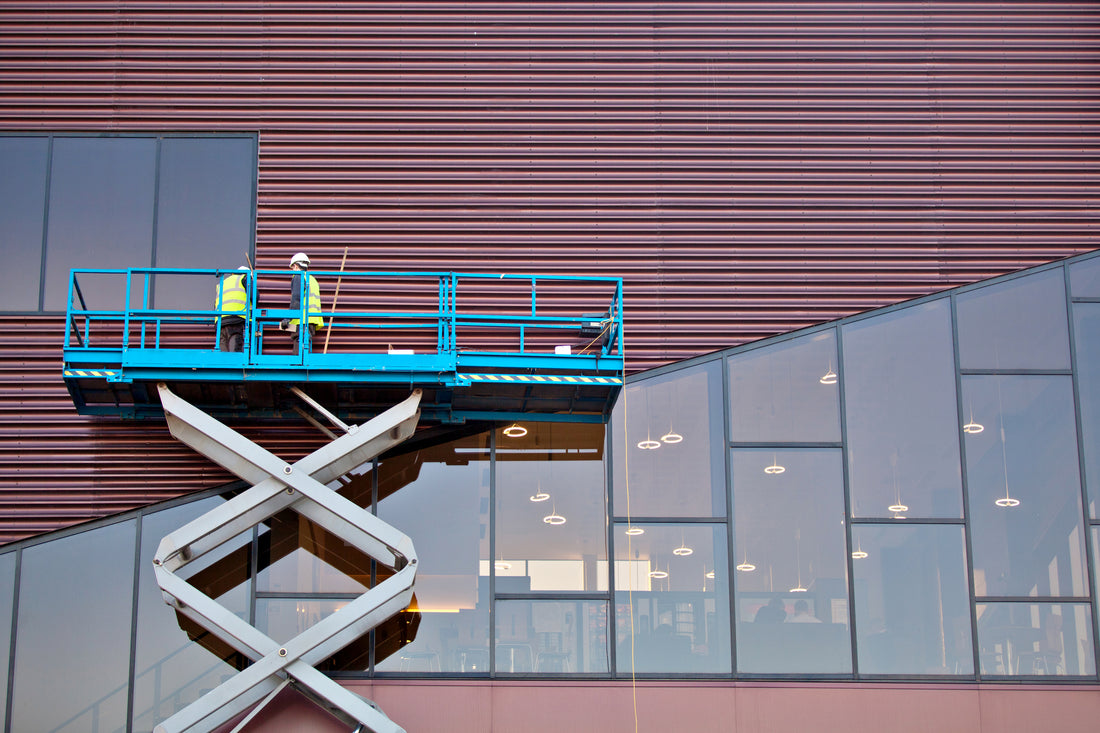Scissor lifts are part of the aerial work platform (AWP) family. Typically, AWPs are motorized vehicles with a work platform. The platform provides a solid foundation to work to be completed at low and medium heights. In particular, scissor lifts leverage a criss-crossing metal support structure that elongates as the platform rises.
“The mechanism to achieve this is the use of linked, folding supports in a criss-cross "X" pattern, known as a pantograph (or scissor mechanism). The upward motion is achieved by the application of pressure to the outside of the lowest set of supports, elongating the crossing pattern, and propelling the work platform vertically. The platform may also have an extending deck to allow closer access to the work area, because of the inherent limits of vertical-only movement.”
Hence, the name, scissor lift!
For reference, other fairly common names for scissor lifts include aerial device, elevating work platform, bucket truck and even mobile elevating work platform.
Ultimately, scissor lifts (and any AWP) helps technicians reach difficult to reach areas and provide stable footing in order to complete any necessary work. Frequently, work teams leverage scissor lifts instead of ladders because of the enhanced safety features. For example, one of the basic operational rules forbids operating the lift while the platform is elevated. Finally, scissor lifts, which vary in size, are great machines for navigating between tight isles (such as in warehouses).
Common Scissor Lift Use Cases
Aerial lifts provide temporary access to typically inaccessible spaces (specifically at heights unreachable or unsafe to work with ladders). Additionally, used properly, aerial lifts are safe, which helps make work more efficient and precise! As a result of the versatility and effectiveness, there are plenty of aerial lift use cases.
“Because of this machine’s ability to cut on-the-ground costs, the investment pays for itself very quickly. However, what are the main uses for these versatile machines? There are actually quite a few!”
- Construction Sites
In particular, sites that require lots of detail (in elevated spaces), scissor lifts allow workers to focus on the task at hand (and not their safety). For example, renovation and general contracting firms benefit from working with scissor lifts.
- Building Maintenance
From changing lights or accessing utilities to hanging banners and signs, building maintenance teams benefit from scissor lifts. In particular, buildings such as churches, libraries, schools and hospitals frequently require work to be completed at elevated heights.
- Warehouses
Scissor lifts remain one of the most effective ways to navigate warehouses filled to their capacity. Lifts help reach inventory stored on the top shelves and efficiently move to the shipping dock for streamlined operations. Plus, lift platforms help move heavy loads, so they improve routine operations (even without the need for high storage space). Related to warehouse use, scissor lifts are effective in manufacturing plants, delivery and rail yard operations, retail centers, property management, landscaping and other similar sectors.
- Telecommunication Maintenance
Field workers in the telecommunications space depend on quality aerial lifts to help maintain (and fix) telephone poles and lines, along with electric lines. These lifts allow field workers to carry all of the required tools and accessories in one trip and work close to the issue to help enhance worker safety.
Generally, scissor lifts work great for jobs that require platform space and lift capacity, power to drive around sites and climb ramps, repetitive assignments and special worksites.
Common Scissor Lift Safety Guidelines
Undoubtedly, scissor lifts offer significant benefits, but they also operate in dangerous conditions. Anytime employees and workers complete tasks off of the ground, danger is front and center. As a result, OSHA provides operators with the common scissor lift safety guidelines.
“Employers need to assess the worksite to identify all possible hazards in order to select the appropriate equipment for the task. Employers who use scissor lifts need to evaluate and implement effective controls that address fall protection, stabilization and positioning. Only trained workers should be allowed to use scissor lifts, and employers should make sure that those workers show that they can use a scissor lift properly. Safe scissor lift use includes properly maintaining the equipment, following the manufacturer’s instructions, providing workers training and needed personal protective equipment (PPE), and implementing safe work practices.”
- Fall Protection - scissor lifts must install guardrails that prevent workers from falling.
- Stabilization - operators must ensure lifts are stable and not susceptible to tipping over or collapsing. In particular, using scissor lifts outside, which is safe, but wind makes them susceptible to tipping.
- Positioning - operators must understand positioning to avoid crushing electrocution hazards, which potentially impacts co-workers and overall site safety.
- Maintaining Scissor Lifts and Inspections - per recent A92.2 standards, OSHA helps oversee updated maintenance procedures and annual inspections.
As part of maintaining scissor lifts, ensuring your operations are fully stocked with replacement equipment helps keep you team fully functioning. Aerial Equipment Parts offers a huge selection of replacement lift equipment for aerial lifts, boom lifts or scissor lifts. Our inventory includes parts for all major brands, including JLG, Genie, SkyJack and Snorkel lifts. If you need to replace any of your lift parts, then search our inventory to find the right part for your scissor lift (or any lift) today. Call or e-mail with any questions! Our staff has years of industry experience and is fully knowledgeable on all products. Shop today!


